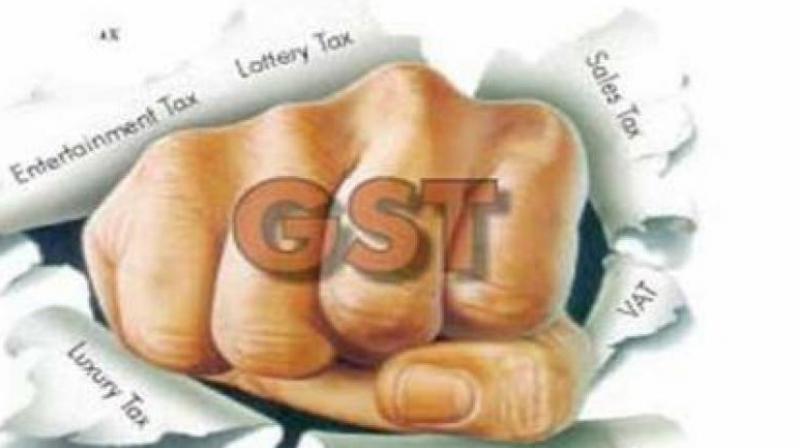Nellore: Top official allays fears over GST
There is total transparency, says JC.

Nellore: Joint Collector of Nellore A. Md. Imtiaz, IAS, who earlier worked as Deputy Commissioner of Commercial Taxes, has said the consumers have lot of advantages because of GST. “In the past, excise duty, service tax and sales tax (VAT) and other indirect taxes like octroi, entry tax etc were levied on the goods at the different levels and now there is only one indirect tax that is GST on goods and services,” he said. Sharing the intricacies of the tax system and the advantages to this newspaper, he clarified various doubts and apprehensions among traders and public over the new tax system. According to Mr Imtiaz, amount of tax paid on the goods and received in the past were not visible – in fact there was cascading of taxes. That is tax was levied on taxes. For example, if excise duty of 12 per cent was paid on particular goods manufactured, VAT at the rate of 14.5 per cent used to be levied on those goods. VAT used to be levied on the excise duty paid also. Consumers were left to think that they had paid only 14.5 per cent tax on the goods, but ended up paying around anywhere between 27 per cent and 30 per cent.
Now, it is not so. There is total transparency and customer knows how much tax is paid. It is visible. Most of the goods and services are taxable at the standard rate of 18 per cent bringing down tax component on many goods. The main advantage for all consumers apart from transparency and simplicity of the system, GST would improve accounting and all taxpayers to report their turnovers and pay taxes and this would lead to a great increase in tax revenue. Reacting to trader’s complaints over too much of paper work, he said a normal taxpayer would be required to furnish three monthly returns and one annual return for GST and those were simple.
He struck down tax practitioner’s claim that small traders also have to hire computer operators and accountants to manage the accounts. “For small taxpayers, there is an option of composition available and any small trader or small manufacturer or service provider having their taxable turnover up to Rs 75 lakh in the last financial year may opt for this scheme. The rate of GST under composition is 1 per cent for trader and 2 per cent for manufacturer and 5 per cent for hoteliers. Such small traders who opt for this composition are required to file tax return in GSTR 4 only quarterly and not monthly. Hence, the government has chosen to ease pressure on small businesses having an annual turnover of up to Rs 75 lakh,” Mr Imtiaz said.
On allegations that GST is a punishment to traders, he said it is incorrect, while adding that the system improves accounting and arrests tax evasion. The design of the system is such that it improves voluntary tax compliance and encourages issue of tax invoices. Exports will be zero rated and will be relieved of all embedded taxes and levies at both Central and state level, he noted. When asked about doubts over car rates going up because of GST, he reminded that post-GST many car manufacturers like Hyundai, Maruti Suzuki and Mahindra have slashed prices on their vehicles. This is a good sign and definitely a result of GST as it reduces cost of logistics and warehousing of the automobile sector, he added.
Played key role in creating awareness about GST:
In 2010, Mr A. Md. Imtiaz, IAS, had written a book titled Glimpses of Goods and Services Tax on Goods and Services Tax (GST) and a second edition of the book was published due to its popularity. He was chosen as the chairman of the technical committee of the All-India Confederation of Commercial Tax Associations in the year 2010-11 and delivered many lectures on GST implementation and its principles across the country from 2010 to 2013 in Hyderabad, Chennai, Bengaluru, Pune and Vijayawada etc.
He created awareness among the officials of state VAT departments of nearly 25 states and his lectures mainly centred around the likely organisational structure of state VAT departments, apart from principles of dual concurrent GST once it is implemented in the country. This awareness helped state VAT officials to air their views successfully before the GST council when final administrative division of functionalities was designed. State VAT officers owe this to the awareness created by Mr. Imtiaz in that period.
Mr Imtiaz had earlier worked as the deputy commissioner of Commercial Tax prior to his getting into Indian Administrative Service on conferment of IAS. He worked for long in the areas of VAT policy and VAT implementation in Andhra Pradesh in 2005 and was involved in drafting VAT law and its procedures. He gained expertise in the subject of sales tax after working with international consultants like Price Waterhouse Coopers, London, and delivered many lectures on VAT in the country at various forums.

